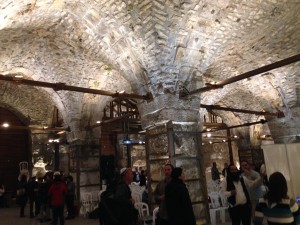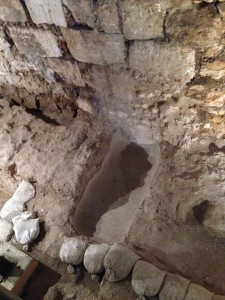Rabbinical tradition talks about two Jerusalems: Upper Jerusalem and Lower Jerusalem. This is usually interpreted as a celestial version of the city as opposed to the earthly city that exists in reality. I would like to suggest a new interpretation: Jerusalem that we can see above ground and a subterranean level. There have been so many below ground excavations taking place in the city, that as far fetched as it may seem, there are plans for tourists to be able to tour the lower levels of the city without disturbing life on the 21st century level. Remember, you read it here first!
I am writing this blog as we approach the Jewish festival of Purim where turning ideas on their head or doing things in the opposite way to usual is very much part of the narrative. In this vein I would like to introduce you to two new sites in “Lower” Jerusalem which can only be seen if you venture below ground level.
The tour along the tunnel following the Western Wall underneath the Moslem Quarter has been open for several years now. However newer excavations that branch off the main tunnel have only recently been revealed to the public. One of the most impressive examples is a six hundred square metre hall with arches that was built in the early Mameluk period. Archeologists date it to the mid thirteen hundreds.


 The Mamluks, who ruled here for just over two hundred and fifty years were ruthless conquerors who, under their leader Baybars, pursued a scorched earth policy all over the country. They were originally from Turkey where as young boys they were sold as slaves to the Egyptian administration. In many of the structures they built they placed signs of their former servitude. A goblet signifies they were once cup bearers and this motif can be seen in various locations throughout the Old City. Despite their long rule, only one Mamluk sultan injected significant funds into Jerusalem when entire streets, religious buildings, and bath-houses were built under his directive.
The Mamluks, who ruled here for just over two hundred and fifty years were ruthless conquerors who, under their leader Baybars, pursued a scorched earth policy all over the country. They were originally from Turkey where as young boys they were sold as slaves to the Egyptian administration. In many of the structures they built they placed signs of their former servitude. A goblet signifies they were once cup bearers and this motif can be seen in various locations throughout the Old City. Despite their long rule, only one Mamluk sultan injected significant funds into Jerusalem when entire streets, religious buildings, and bath-houses were built under his directive.
The hall we can visit was part of an internal central courtyard between two housing complexes and very close to two bath-houses we know were built in 1328 by the Mamluk SultanTankiz. Finds dating from the time Roman legions were stationed in Jerusalem have been unearthed here as well as a stone goblet which archeologists surmise might have been used by the Cohanim or priestly class in the Second Temple Period. Possibly they lived in the vicinity in an earlier time. During the Roman period there may have been a fortified tower in this location as it was so close to the area of the Temple.
As in many cases, this wonderful discovery was found by accident. It was originally underneath a dormitory in a boys’ yeshiva (religious seminary). One of the more adventurous lads started exploring and due to the pointed shape of the arches thought he was in a Crusader Church, so made a hasty exit. The Israeli Antiquities Authority was duly notified and excavations began in earnest. They too originally thought they had unearthed a Crusader structure, but ceramics from the early Mamluk period found at the bottom of the pillar bases made them change their minds.
Remnants of an earthquake in 1546 were found here as was an unexploded mortar shell from the War of Independence in 1948. The “Davidka” was a home made Israeli device that was known for its loud bombs and its inaccuracy! When the excavators identified their find they weren’t quite sure what to do with it. One of them had the bright idea of contacting the army museum. The museum was incredibly excited by the find as they knew of four Davidka mortars fired in Jerusalem, but only two had been discovered, now they knew the location of a third!
The other recently opened site is actually entered from above ground level. Once inside you descend a metal staircase where each rung takes you further back in time until you reach the Second Temple Period. This fascinating excavation is located just inside the Jaffa Gate in the former Turkish prison compound: the Kishle. Visiting this condensed archeological site with its historical remains in such close proximity to each other gives you a tangible sense of the antiquity of Jerusalem and the archeological footprints left on the city by its inhabitants.
 At the highest (entrance) level there is some interesting graffiti which dates to Mandate times when the prison was used by the British to incarcerate members of the Jewish underground organizations. One such prisoner was Shmuel Matza. He was only twenty when he was held there as the British had caught him in possession of a weapons cache. He was put in a cell for four days and remembers sleeping in rags on the floor that were crawling with lice and tics. The conditions were really terrible, dark and airless, with twenty prisoners sleeping in one cell. He relieved his boredom by incising the symbol of the Irgun (a military movement competing with the Hagana) on the wall and the words “Long Live the Hebrew State”. The prisoners weren’t given any knives with which to eat their food, so he carved it out with his fork. This act of rebellion took place in 1947 during the time of the British Mandate when there was no certainty the state would be founded the following year. Matza, who become a Jerusalem lawyer was traced by the archeologists because in another graffiti he carved out his own name!
At the highest (entrance) level there is some interesting graffiti which dates to Mandate times when the prison was used by the British to incarcerate members of the Jewish underground organizations. One such prisoner was Shmuel Matza. He was only twenty when he was held there as the British had caught him in possession of a weapons cache. He was put in a cell for four days and remembers sleeping in rags on the floor that were crawling with lice and tics. The conditions were really terrible, dark and airless, with twenty prisoners sleeping in one cell. He relieved his boredom by incising the symbol of the Irgun (a military movement competing with the Hagana) on the wall and the words “Long Live the Hebrew State”. The prisoners weren’t given any knives with which to eat their food, so he carved it out with his fork. This act of rebellion took place in 1947 during the time of the British Mandate when there was no certainty the state would be founded the following year. Matza, who become a Jerusalem lawyer was traced by the archeologists because in another graffiti he carved out his own name!
Moving further down the steps, we see the remnants of the original Turkish wall from when the Kishle was first constructed in the 1830’s. About half way down the staircase we notice a small basin which dates from the time of the Crusaders. Eight small basins like this one were discovered within the area, but only two of them were left in situ and the rest were dismantled in order to excavate layers below. The archeologists’ original theory was that these basins were used by tanners to dampen their hides. However, records show that in Crusader times the citadel was used as a castle and this very smelly process would have been far too close for comfort. According to the Jewish traveller Benjamin of Tudela, who visited the city from 1169-1172, this area was used by cloth dyers for dying their fabrics. The pigment would have been put in these basins and the fabric left in it to absorb the colour. Remains of a red pigment have been found in the plaster of the basin. In his travel journal Benjamin of Tudela wrote that the Jews paid an annual tax to the king to retain the exclusive right to be dyers. He also mentions Jews living under the Tower of David practicing their profession as dyers. This basin would seem to corroborate his description. We also learn from the writings of the Ramban (Rabbi Moshe ben Nahmanides), who came to the city in 1267, about two Jewish cloth dyers he encountered with whom he undertook the task of reestablishing the Jewish community of Jerusalem.
Once we reach the bottom of the steps we peer down into excavations from three different eras. The oldest period dates back to the time of King Hezekiah (8th cent BCE) when he was defending the city from the Assyrians in 701 BCE. Exposed here is a wall he built at the western border of the city. There is reason to believe it was part of the same city wall of which the Broad Wall we see in the Jewish Quarter is a section.
You can also see remnants of the city wall from the Hasmonean period (2nd cent BCE) and how they extended the western perimeter of Jerusalem by a few metres. However, the most important find in this excavation dates to the time of King Herod. On either side of the Hasmonean wall Herod built retaining walls in order to create a platform on which to build his palace, this stretched 500 metres in the direction of the Armenian Quarter, under the present day police station and was 150 meters wide. Only the very base of this palace has been discovered and we can only see one of these walls.
Herod actually destroyed the Hasmonean wall in order to build this platform. Amit Re’em, the archeologist in charge of the excavation, suggests two reasons he might have done this. One is because the engineering involved changing the angle of the wall which rendered the Hasmonean structure unsuitable. The second reason is a political one. Herod had been hounded by the Hasmoneans and fought bitter battles with them. By destroying the remnants of their wall, he signified a new regime had taken control, of which he was the leader.
This discovery also has very important ramifications for the Christian community. At present, the site of the Praetorium, the place where Jesus was said to be judged by the Roman procurator Pontius Pilate is said to be located at the very start of the Via Dolorosa, on the other side of the Old City near the Lions Gate. If Herod’s palace which was later taken over by the Roman procurator is indeed here, the traditional route may need to be adapted to take this new archeological discovery into account.
